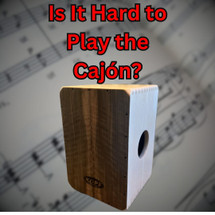Posted by Steve Head on 13th Aug 2024
Is It Hard to Play the Cajon? A Guide for Beginners
As the owner of Kopf Percussion, I often get asked, "Is it hard to play the cajón?" The answer to this question can vary depending on your experience level, musical background, and how deeply you want to explore the instrument. However, in general, the cajón is one of the most accessible percussion instruments to learn, making it a great choice for beginners while offering plenty of depth and complexity for more experienced musicians.
The Accessibility of the Cajón
One of the reasons the cajón is so popular is because it’s relatively easy to pick up and start playing. Unlike other percussion instruments, the cajón doesn’t require any specialized sticks, mallets, or hardware. All you need are your hands (and maybe some brushes or mallets if you want to experiment). The cajón is essentially a wooden box that produces different sounds depending on where and how you strike it. This simplicity is a big part of its appeal.
Basic Techniques
For beginners, learning the basic playing techniques is straightforward. The two primary sounds produced by a cajón are the bass and the snare.
- Bass: To produce a deep bass sound, you strike the center of the cajón’s front faceplate with the flat of your hand.
- Snare: For a snare-like sound, you strike closer to the top edge of the faceplate, using either your fingers or the edge of your hand.
These basic techniques are easy to grasp, and with a bit of practice, you can start playing simple rhythms in no time. The lack of complex mechanics or a steep learning curve makes the cajón an excellent instrument for beginners or those new to percussion.
Developing Your Skills
While the basics of playing the cajón are easy to learn, there’s plenty of room for growth and development. As you become more comfortable with the instrument, you can start to experiment with different rhythms, dynamics, and techniques. Here’s how you can take your playing to the next level:
Advanced Techniques
- Ghost Notes: These are softer, subtler notes played between the main beats. They add texture and complexity to your rhythms and are crucial for more advanced cajón playing.
- Slaps: These are sharp, high-pitched sounds produced by striking the edge of the faceplate with the fingertips. Slaps are often used in flamenco and other styles to add a snappy, percussive element.
- Brushes and Mallets: While the cajón is traditionally played with the hands, many players also use brushes or mallets to create different textures and sounds. This technique can add a new dimension to your playing.
Polyrhythms and Syncopation
As you become more advanced, you can start to explore polyrhythms and syncopation. Polyrhythms involve playing two or more contrasting rhythms simultaneously, while syncopation involves placing emphasis on the off-beats or weaker beats of a rhythm. Both techniques add complexity and interest to your playing and are commonly used in styles like jazz, funk, and Latin music.
The Versatility of the Cajón
Another reason why the cajón is easy to start with yet challenging to master is its versatility. The instrument is used in a wide range of musical genres, from flamenco and Afro-Peruvian music to pop, rock, and jazz. Each style requires different techniques and approaches, allowing you to continually expand your skills and adapt your playing to different musical contexts.
At Kopf Percussion, we’ve seen musicians of all backgrounds embrace the cajón for its adaptability. Whether you’re accompanying an acoustic guitar, playing in a full band, or even using it in a studio setting, the cajón can fit into virtually any musical environment. This versatility keeps the instrument interesting and engaging, no matter how experienced you become.
Common Challenges and How to Overcome Them
While the cajón is accessible, it does come with its own set of challenges, especially as you progress to more advanced levels. Here are some common challenges and tips on how to overcome them:
Hand Technique and Endurance
Playing the cajón requires a lot of handwork, and this can lead to fatigue, especially if you’re playing for extended periods. To avoid this, focus on developing good hand technique. Make sure you’re striking the cajón with the correct part of your hand and using your wrist rather than your arm to generate power. Practicing regularly will also build up the necessary endurance.
Dynamic Control
Another challenge is mastering dynamic control. The cajón can produce a wide range of volumes, from very soft to very loud, and learning to control these dynamics is key to expressive playing. Start by practicing playing at different volumes and working on transitions between soft and loud passages. This will give you greater control over the instrument and improve your overall musicality.
Rhythmic Complexity
As you advance, you might find it challenging to play more complex rhythms, especially if they involve polyrhythms or syncopation. The best way to tackle this is through consistent practice. Break down complex rhythms into smaller, more manageable parts, and practice each part slowly before gradually increasing the tempo. Using a metronome can also help you stay on beat and improve your timing.
Learning Resources
There are plenty of resources available to help you learn and improve your cajón playing. At Kopf Percussion, we’re passionate about helping musicians get the most out of their instruments, and we encourage you to take advantage of online tutorials, instructional videos, and cajón method books. Whether you’re just starting out or looking to refine your skills, there’s always something new to learn.
Final Thoughts: Is It Hard to Play the Cajón?
In conclusion, the cajón is one of the most accessible percussion instruments out there, making it an excellent choice for beginners. The basic techniques are easy to learn, and you can start playing simple rhythms almost immediately. However, the cajón also offers plenty of depth and complexity for those who want to take their playing to the next level. With practice and dedication, you can master advanced techniques, explore different musical styles, and continually challenge yourself as a musician.
At Kopf Percussion, we believe that the cajón is an instrument that can grow with you. Whether you’re just starting your musical journey or you’re an experienced percussionist, the cajón offers endless possibilities for creativity and expression. So, is it hard to play the cajón? It’s as easy—or as challenging—as you want it to be. And that’s part of what makes it such a rewarding instrument to play.
If you’re ready to go a little deeper, take a look at my newer post, Learning Cajon the Right Way




